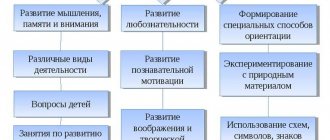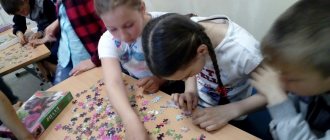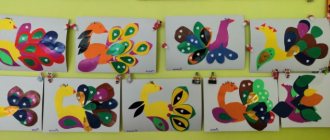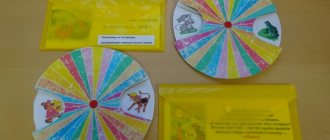How does cognitive interest arise in preschoolers?
Cognitive interest is not formed out of nowhere or at the will of parents. It appears when a child encounters something completely new that does not fit into the “matrix” of his knowledge and experience. Surprise and puzzlement appear. The riddle haunts the preschooler until he clears up the keys to the answer.
Example. Deniska, 3.5 years old, saw a small tractor with a body in front. The first thing the kid asked was: “Why is the tractor driving backwards?” After listening to the answer, he walked a few steps backwards, just in case. Then came the conclusion: “So the driver sees that he is lucky.”
The child saw a flower bloom on the windowsill, and he is ready to water the indoor plants every day to repeat the phenomenon. He watches his grandmother knead the dough, and he certainly wants to practice turning loose flour into plastic dough.
The preschooler wants to join activities that awaken emotions and experiences. Even putting together puzzles and construction sets gets the child interested in the fact that the result should be a beautiful picture or model.
Some objects and phenomena captivate the child for a short time, others hold attention for a long time. The main forms of expression of interest can be identified:
- Curiosity is a primary interest in a subject, object or event.
- Curiosity is the desire to study a subject in more detail, to find its still hidden properties. At this stage, the joy of learning new things is formed. Research is carried out using trial methods or questions.
- Direct cognitive interest is characterized by the emergence of a task or situation in which the child seeks to understand independently, to understand the true essence of the phenomenon. At this stage, the mechanisms are dismantled into individual screws or the doll is disassembled into its components to find out what’s inside.
What maintains cognitive interest in preschool age
Cognitive interest can easily fade away if it is not nourished. Adults play a certain role here, encouraging the child to continue, but the main factors that stimulate continuation are cognitive independence and the presence of motivation.
In the process of learning something new, there is a combination of feelings and the intellectual component. A preschooler feels a sense of admiration when he learns that the seasons in the southern hemisphere follow different principles.
The joy of learning new things causes impatience and complete fascination with a toy or book that contains new information. Dismantling an alarm clock or kitchen appliances provokes such excitement that the young explorer may not notice his parents watching him.
Small experiments that can be carried out with the help of numerous sets of young physicists and chemists make you freeze in anticipation of the result. And finally, nothing motivates you to continue learning more than a solution achieved on your own.
Cognitive independence
Starting from the age of five, a preschooler increasingly asks chains of clarifying questions. He becomes interested in a specific subject or process, asks the main question that worries him, but the answer he receives prompts him to further research and new questions.
The essence of cognitive independence lies in the fact that the child himself, without additional incentives, feels ready to acquire new knowledge.
Older preschoolers can express their disagreement with the answer, offer their own version and persistently find out where their assumption is wrong. If it is necessary to obtain additional information, preschoolers themselves initiate a conversation with an adult and ask questions, filling in gaps in their knowledge.
One of the main conditions for the manifestation of cognitive independence is the sufficient development of the volitional sphere. When solving a task set for yourself, you need to finish the job, even if you encounter obstacles: screws don’t unscrew, parts don’t fit together, you can’t draw as your imagination suggests.
Cognitive motivation
Motivation is the second pillar on which cognitive interest stands. An adult’s verbal offer to assemble a model or read a book is not valid. It is necessary that the child is passionate about the process himself and strives to continue or begin the study.
The formation of cognitive motivation in preschool children is closely related to the development of voluntary attention.
A task that previously intrigued a child may turn out to be quite difficult for him. To continue to solve it, you need to maintain attention and remember the goal. This is beyond the power of younger preschoolers who have not yet learned to manage their attention.
Psychologists identify the conditions necessary for the formation of cognitive motivation of a preschooler:
- Emotional support. A child retains attention and interest in a task longer if he is encouraged, praised, and supported.
- Activation of thought processes. Minor hints for the child, an offer to check another version, inspires the young researcher. He comes up with an immediate goal and ideas on how to achieve it.
- Discussing successes and failures, encouraging the child to independently find explanations for why it was or was not possible to find a solution.
Cultivating curiosity gives rise to the independent habit of looking for everything unknown and incomprehensible in the surrounding space. Learning new things becomes a need for a child and motivates him to take cognitive actions, be it learning to read or compiling a collection.
Introduction
The development of cognitive activity in preschool children The Federal State Educational Standard for 2013 considers the formation of cognitive interests and cognitive actions of the child in various types of activities as the main principle of preschool education. In addition, the standard is aimed at developing the intellectual qualities of preschoolers. According to it, the program should ensure the development of the personality of preschool children in various types of activities.
This document interprets cognitive development as an educational area, the essence of which is revealed as follows: the development of curiosity and cognitive motivation; formation of cognitive actions, formation of consciousness; development of imagination and creative activity; the formation of primary ideas about oneself, other people, objects of the surrounding world, their properties and relationships (shape, color, size, material, sound, rhythm, tempo, quantity, number, part and whole, space and time, movement and rest, causes and consequences, etc.), about the small homeland and Fatherland, ideas about the socio-cultural values of our people, about domestic traditions and holidays, planet Earth as the common home of people, about the peculiarities of its nature, the diversity of countries and peoples of the world.
This understanding of the cognitive development of preschool children suggests viewing it as a process of gradual transition from one stage of development of cognitive activity to another.
We include the following stages of cognitive development: curiosity, inquisitiveness, development of cognitive interest, development of cognitive activity.
Let's look at each of the stages in more detail.
1. We consider curiosity to be the first stage. It is characterized by a selective attitude towards any subject, conditioned by purely external aspects and circumstances that are often suddenly revealed to the child. At this stage, the preschooler is content with only the initial orientation associated with the interestingness of the subject itself; entertainment as a factor in the discovery of cognitive interest usually serves as its initial impetus. As an example of the manifestation of curiosity in a preschooler, we can cite the fact that at 2–3 years old a child focuses on the brightness of an object, without paying much attention to its essence.
2. The second stage of cognitive development of preschool children is defined as curiosity, which is a valuable state of personality, an active vision of the world, characterized by the child’s desire to penetrate beyond what was initially perceived and perceived. At this stage of interest, as a rule, strong emotions of surprise, joy of learning, delight, and satisfaction with the activity are manifested. The essence of curiosity lies in the formation and deciphering of various kinds of riddles.
3. A new quality, or stage, of the cognitive development of preschoolers is cognitive interest, characterized by increased stability, clear selective focus on a cognizable object, valuable motivation, in which cognitive motives occupy the main place. Cognitive interest facilitates the preschooler’s penetration into essential relationships, connections, and patterns of mastering reality. A manifestation of cognitive interest should be considered the child’s desire to independently answer questions posed, for example, during experimentation or exploration of the world around him.
4. We consider cognitive activity, the basis of which is a holistic act of cognitive activity - an educational-cognitive task, to be a high level of cognitive development of preschool children.
It should be noted that the Federal State Educational Standard for Educational Education focuses on the specific content of educational areas for implementation in certain types of activities, paying special attention to cognitive-research (studying objects of the surrounding world and experimenting with them).
Recommended activities that ensure the cognitive development of preschool children include:
– organization of solving cognitive problems;
– the use of experimentation in the work of preschool educational institutions;
– use of design.
When working with preschoolers, cognitive tasks are used, which are understood as educational tasks that presuppose the presence of search knowledge, methods (skills) and stimulation of the active use of connections, relationships, and evidence in learning. A system of cognitive tasks accompanies the entire learning process, which consists of sequential activities that gradually become more complex in content and methods.
After children accept a cognitive task, under the guidance of a teacher, it is analyzed: identifying the known and the unknown. As a result of the analysis, children make assumptions about the possible course of a natural phenomenon and its causes. Their assumptions are right and wrong, often contradictory. The teacher must listen and take into account all assumptions and pay attention to their inconsistency. If the children do not put forward any ideas, the teacher himself should put them forward.
Effective methods of cognitive development of preschoolers include project activities that ensure the development of children’s cognitive interests, the ability to independently construct their knowledge and navigate the information space, and the development of critical thinking.
Development of cognitive interests in older preschoolers
In older preschool age, the relationship between cognitive interest and attention increases significantly. During this period, children realize that the correct result largely depends on how carefully all the details were taken into account.
The arbitrariness of the attention function is also formed; children are able to concentrate on a task without being distracted by foreign objects or situations.
The progressive development of cognitive processes leads to the fact that older children analyze more, learn to highlight the main thing and abstract from unimportant signs. On the one hand, they are more capable of finding answers to their questions, but, on the other hand, their cognitive interests cover more areas.
At this stage, a cognitive interest in mathematics is formed. Preschoolers are interested in performing simple arithmetic operations, measuring objects, and solving logic problems.
Search and experimental activities play a significant role in the development of cognitive activity. The child is an experimenter. Understanding the world through experience is its natural state. In addition, the result obtained as part of the experiment is assimilated much better than just an adult’s story.
During the experiment, the older preschooler, on his own, receives answers to questions that are significant at his age: “How?” and why?". You can tell your child all you want about the laws of aerodynamics, but he won’t understand what you’re talking about until he flies a kite.
On walks or excursions, children get the opportunity to constantly experiment: why a leaf floats down a stream, why snow melts; see that the plucked branch will dry out or, conversely, take root in a glass of water.
In essence, cognitive research activities are close to experiments. It involves experimentation, but also uses collecting to teach how to classify objects according to various characteristics. You can collect herbariums and stamps, as well as figurines from the robot collection.
Excursions help you explore a piece of space along which the route is laid. Educational activities consist of acquiring minimal cartography skills, studying the plants and habits of animals encountered along the way.
The role of an adult in the formation of cognitive interest of preschool children
The main task of adults at the stage of formation of cognitive interest is to maintain the motivation of a preschooler and use methods that help keep children’s attention and complete the task.
Parents need to make sure not only that there are reference books and encyclopedias suitable for preschool age in the house, but also regularly read with their child materials that enrich the child’s knowledge. It is useful to use non-standard developmental methods. For example, finger games for children are exciting in their practical implementation and bring tangible benefits to the development of fine motor skills.
The main lines of work in the development of children's cognitive interest:
- Supporting the child's desire to ask questions. Expressed in a favorable attitude and detailed explanation instead of short answers and excuses.
- Additional stimulation of cognitive interest. It consists of exciting stories, identifying topics that interest the preschooler, expanding answers, going beyond the topic. For example, when talking about hours and minutes, you can touch on the calendar.
- Application of games. For preschoolers, this is the main activity in which new skills are learned. You can build games in the form of “question-answer” or correct information that the child uses incorrectly when playing with peers.
- Supporting a preschooler in his research. Praise upon achievement of a result and during the activity so that the child understands that his efforts aimed at solving the problem are important.
- Help in mastering planning and goal setting skills.
Adult support for a child's curiosity in relation to any area of life will lead to the presence of developed cognitive interest. And this is a good deposit for upcoming school success and diversified personality development at any age stage.
Bibliography
- Ivanenko S.F., Formation of speech perception in children with severe speech impairment. M., 2004.
- Markova L.S. Organization of correctional and developmental education for preschoolers with mental retardation. Practical guide. – M, 2005
- Federal State Educational Standard for Preschool Education, 2013.
- Khudenko E.D., Melnikova T.S., Shakhovskaya S.N. How to teach a child to think and speak? // NPF "Uniserv". – M.: 1993. – 172 p.
- Shevchenko S.G. Preparing children with mental retardation for school. Book 1 / Generally ed. S.G. Shevchenko. – M.: School Press, 2003. – 96 p.






